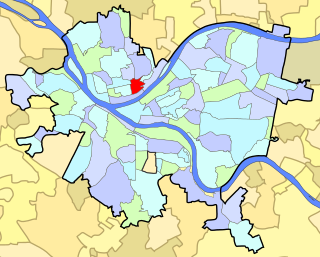
East Allegheny, also known as Deutschtown, is a neighborhood on Pittsburgh's North Side. It has a ZIP code of 15212, and has representation on Pittsburgh City Council by the council member for District 1. The Pittsburgh Bureau of Fire houses 32 engines and 32 trucks in Deutschtown.

Fineview — known to older generations as Nunnery Hill — is a neighborhood on Pittsburgh's North Side with expansive views of downtown Pittsburgh. The most famous of these views is from the Fineview Overlook at the corner of Catoma Street and Meadville Street.

Troy Hill is a neighborhood on Pittsburgh, Pennsylvania's North Side. It has a zip code of 15212, and has representation on Pittsburgh City Council by the council member for District 1.
Ronald Reagan Cross County Highway, formerly and locally known as Cross County Highway, is a west-east freeway in Hamilton County, Ohio, United States. It stretches 16.4 miles (26.4 km) from southern Colerain Township to Montgomery, connecting many of Cincinnati's northern suburbs to Interstate 71 and Interstate 75. State Route 126 is routed over most of the highway, while the remainder is a county-maintained road.
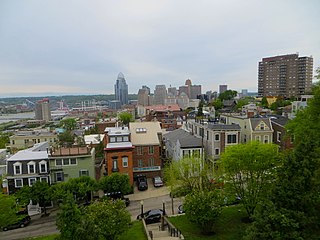
Mount Adams is a geographic landmark and residential neighborhood of Cincinnati, Ohio, located directly east of downtown Cincinnati, south of Walnut Hills, southwest of East Walnut Hills, and west of the East End. The population was 1,578 at the 2020 census.

The Church of the Immaculata, or Immaculata Church, is a Roman Catholic church atop Mt. Adams, a neighborhood in Cincinnati, Ohio. The church commemorates the Immaculate Conception and serves the Holy Cross–Immaculata Parish in the Archdiocese of Cincinnati. Located at 30 Guido Street, it allows a scenic view of the Ohio River below from one of the highest points in Cincinnati.
Wesley Chapel was a Methodist church in Cincinnati, Ohio, United States. Built in 1831 on the north side of Fifth Street between Broadway and Sycamore, it was a simple red brick Georgian structure copied after John Wesley's original Methodist church in London. With 1,200 seats, it was the largest meeting place west of the Alleghenies and the largest building in Cincinnati for many years. It was the seat of Methodism in Cincinnati.

Prospect Hill Historic District is located on a hillside outside of downtown Cincinnati, Ohio, United States. It is part of the Mount Auburn neighborhood of Cincinnati. Prospect Hill is bounded by the following streets, Liberty, Sycamore, Boal and Highland. Prospect Hill is sometimes called locally "Liberty Hill".

Mount Auburn Historic District is located in the Mount Auburn neighborhood of Cincinnati, Ohio. It extends along both sides of Auburn Avenue roughly between Ringold Street and William H. Taft Road. The population of Mount Auburn was 5,094 at the 2020 census.
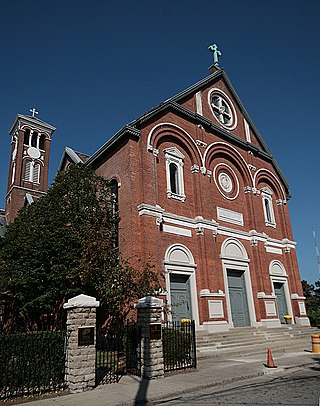
Holy Cross Monastery and Church is a registered historic building complex in Cincinnati, Ohio, listed in the National Register on September 13, 1978. Closed in 1977, it is now the corporate headquarters of a property management company, and an event space.

Interstate 75 (I-75) runs from Cincinnati to Toledo by way of Dayton in the US state of Ohio. The highway enters the state running concurrently with I-71 from Kentucky on the Brent Spence Bridge over the Ohio River and into the Bluegrass region. I-75 continues along the Mill Creek Expressway northward to the Butler County line just north of I-275. From there, the freeway runs into the Miami Valley and then passes through the Great Black Swamp before crossing into Michigan.
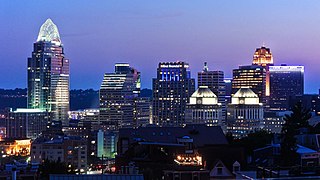
Cincinnati is a city in and the county seat of Hamilton County, Ohio, United States. Settled in 1788, the city is located at the northern side of the confluence of the Licking and Ohio rivers, the latter of which marks the state line with Kentucky. The city is the economic and cultural hub of the Cincinnati metropolitan area and with an estimated population of 2,265,051, it is Ohio's largest metropolitan area and the nation's 30th-largest city. The population of Cincinnati is 309,317 which makes the city the third-most populous city in Ohio after Columbus and Cleveland, and 65th in the United States.

West End is a neighborhood in Cincinnati, Ohio, United States, located northwest of downtown, east of Queensgate, west of Over-the-Rhine, and southeast of Fairview. The population was 6,824 at the 2020 Census.

The Connector is a streetcar system in Cincinnati, Ohio, United States. The system opened to passengers on September 9, 2016. The streetcar operates on a 3.6-mile (5.8 km) loop from The Banks, Great American Ball Park, and Smale Riverfront Park through Downtown Cincinnati and north to Findlay Market in the northern edge of the Over-the-Rhine neighborhood. Future extensions have been proposed to the Uptown area, home to the University of Cincinnati, the regional hospitals on Pill Hill, and the Cincinnati Zoo; and to Northern Kentucky.

Downtown Cincinnati is the central business district of Cincinnati, Ohio, United States, as well the economic and symbiotic center of the Cincinnati metropolitan area. Originally the densely populated core of the city, the neighborhood was transformed into a commercial zone in the mid-20th century. The population was 5,835 at the 2020 census.
The history of Over-the-Rhine is almost as deep as the history of Cincinnati. Over-the-Rhine's built environment has undergone many cultural and demographic changes. The toponym "Over-the-Rhine" is a reference to the Miami and Erie Canal as the Rhine of Ohio. An early reference to the canal as "the Rhine" appears in the 1853 book White, Red, Black, in which traveler Ferenc Pulszky wrote, "The Germans live all together across the Miami Canal, which is, therefore, here jocosely called the 'Rhine'." In 1875 writer Daniel J. Kenny referred to the area exclusively as "Over the Rhine". He noted, "Germans and Americans alike love to call the district 'Over the Rhine'."
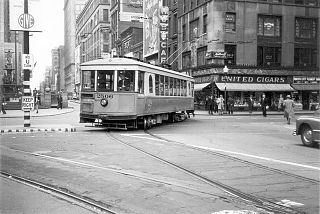
Streetcars operated by the Cincinnati Street Railway were the main form of public transportation in Cincinnati, Ohio, at the end of the 19th century and the start of the 20th century. The first electric streetcars began operation in 1889, and at its maximum, the streetcar system had 222 miles (357 km) of track and carried more than 100 million passengers per year. A very unusual feature of the system was that cars on some of its routes traveled via inclined railways to serve areas on hills near downtown. With the advent of inexpensive automobiles and improved roads, transit ridership declined in the 20th century and the streetcar system closed in 1951.

Transportation in Cincinnati includes sidewalks, roads, public transit, bicycle paths, and regional and international airports. Most trips are made by car, with transit and bicycles having a relatively low share of total trips; in a region of just over 2 million people, less than 80,000 trips are made with transit on an average day. The city is sliced by three major interstate highways, I-71, I-74 and I-75, and circled by a beltway several miles out from the city limits. The region is served by two separate transit systems, one on each side of the river. SORTA, on the Ohio side is about six times larger than TANK on the Kentucky side.
Two buildings in Cincinnati were known as the United States Marine Hospital. They were part of the U.S. Marine Hospital system, which was run by the Marine Hospital Service and its successor the Public Health Service, primarily for the benefit of the civilian merchant marine. The first was completed in 1860, but never used as a Marine Hospital as it was operated as a military hospital during the American Civil War, and was later sold to become Good Samaritan Hospital. The second was a former mansion that operated as a Marine Hospital during 1882–1905; it was later used as a water pollution field station that grew into the U.S. Public Health Service's primary environmental health research program, and the predecessor to the current Andrew W. Breidenbach Environmental Research Center.














